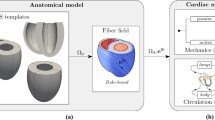Abstract
The problem considered is that of trying to determine the potential distribution inside a human torso as a result of the heart's electrical activity. We describe here a high order (cubic Hermite) coupled finite element/boundary element procedure for solving such electrocardiographic potential problems inside an anatomically accurate human torso. Details of the cubic Hermite boundary element procedure and its coupling to the finite element method are described. We then present two and three dimensional test results showing the success, efficiency and accuracy of this high order coupled technique. Some initial results on an anatomically accurate torso are also given.
Similar content being viewed by others
References
Bradley, C. P.; Pullan, A. J.; Hunter, P. J. 1995: ‘Geometric modelling of the human torso using cubic Hermite elements’, Submitted to Annals of Biomedical Engineering
Brebbia, C. A.; Telles, J. C. F.; Wrobel, L. C. 1984: Boundary element techniques: theory and applications in engineering, Spring-Verlag, New York
Downer, G. E.; Bastos, M. H.; Osborne, J. A. 1980: ‘On deriving the electrocardiogram from vectorcardiographic leads.’ Clin. Cardiol. 3: 87–95
Gale, T. J.; Kilpatrick, D.; Johnson, P. R.; Nicholls, P. M. 1983: ‘A three-dimensional boundary element model of the electric field from implantable defibrillators’, Boundary Element Communications 5 (1): 12–14
Gulrajani, R. M.; Mailloux, G. E. 1983: ‘A simulation study of the effects of torso inhomogeneities on electrocardiographic potentials, using realistic heart and torso models’, Circ. Res. 52: 43–56
Huiskamp, G. J.; vanOosterom, A. 1988: The depolarization sequence of the human heart surface computed from measured body surface potentials’, IEEE Trans. Biomed. Eng. 35 (12): 1047–1059
Hunter, P. J.; Nielson, P. M. F.; Smaill, B. H.; LeGrice, I. J.; Hunter, I. W. 1993: An anatomical heart model with applications to myocardial activation and ventricular mechanics, in T. C. Pilkington, B. Loftis, J. F. Thompson, S. L.-Y. Woo, T. C. Palmer and T. F. Budinger, eds, ‘High-Performance Computing in Biomedical Research’, CRC Press, Boca Ration, Flordia, pp. 3–26
Johnson, C. R.; MacLeod, R. S.; Ershler, P. R. 1992: ‘A computer model for the study of electrical current flow in the human thorax’, Computers in Biology and Medicine 22 (5): 305–323
Karlon, W. J.; Eisenberg, S. R.; Lehr, H. L. 1993: ‘Effects of paddle placement and size on defibrillation current distribution: A three-dimensional finite element model’, IEEE Trans. Biomed. Eng. 40 (3): 246–255
Lachat, J. C.; Watson, J. O. 1976: ‘Effective numerical treatment of boundary integral equations: A formulation for three-dimensional electrostatics’, Int. J. Numer. Methods Eng. 10: 991–1005
Liu, Y.; Rizzo, F. J. 1992: A weakly singular form of the hypersingular boundary integral equation applied to 3D acoustic wave problems’, Computer Methods in Applied Mechanics and Engineering 96: 271–287
Liu, Y.; Rudolphi, T. J. 1991: Some identities for fundamental solutions and their applications to weakly-singular boundary element formulations’, Engineering Analysis with Boundary Elements 8 (6): 301–311
Nielsen, P. M. F.; LeGrice, I. J.; Smaill, B. H.; Hunter, P. J. 1991 ‘Mathematical model of geometry and fibrous structure of the heart’, Am. J. Physiol. 260 (29 (Heart Circ. Physiol)), H1365-H1378
Rudy, Y.; Plonsey, R. 1979. ‘The eccentric spheres model as the basis for a study of the role of geometry and inhomogeneities in electrocardiogrphy’, IEEE Trans. Biomed. Eng. 26 (7): 392–399
Stanley, P. C.; Pilkington, T. C. 1989: ‘The combination method: A numerical technique for electrocardiographic calculations’, IEEE Trans. Biomed. Eng. 36 (4): 456–461
Stanley, P. C.; Pilkington, T. C.; Morrow, M. N.; Ideker, R. K. 1991: ‘An assessment of variable thickness and fiber orientation of the skeletal muscle layer on electrocardiogrpahic calculations’, IEEE Trans. Biomed. Eng. 38 (11): 1069–1076
Telles, J. C. F. 1987: ‘A self-adaptive co-ordinate transformation for efficient numerical evaluation of general boundary element integrals’, Int. J. Numer. Methods Eng. 24: 959–973
Tomlinson, K. A.; Bradley, C. P.; Pullan, A. J. 1996: ‘On the choice of a derivative boundary element formulation using hermite interpolation’, Int. J. Numer. Methods Eng. 39: 451–468
Author information
Authors and Affiliations
Additional information
Communicated by T. Cruse, 8 April 1996
Rights and permissions
About this article
Cite this article
Pullan, A.J., Bradley, C.P. A coupled cubic hermite finite element/boundary element procedure for electrocardiographic problems. Computational Mechanics 18, 356–368 (1996). https://doi.org/10.1007/BF00376131
Issue Date:
DOI: https://doi.org/10.1007/BF00376131




